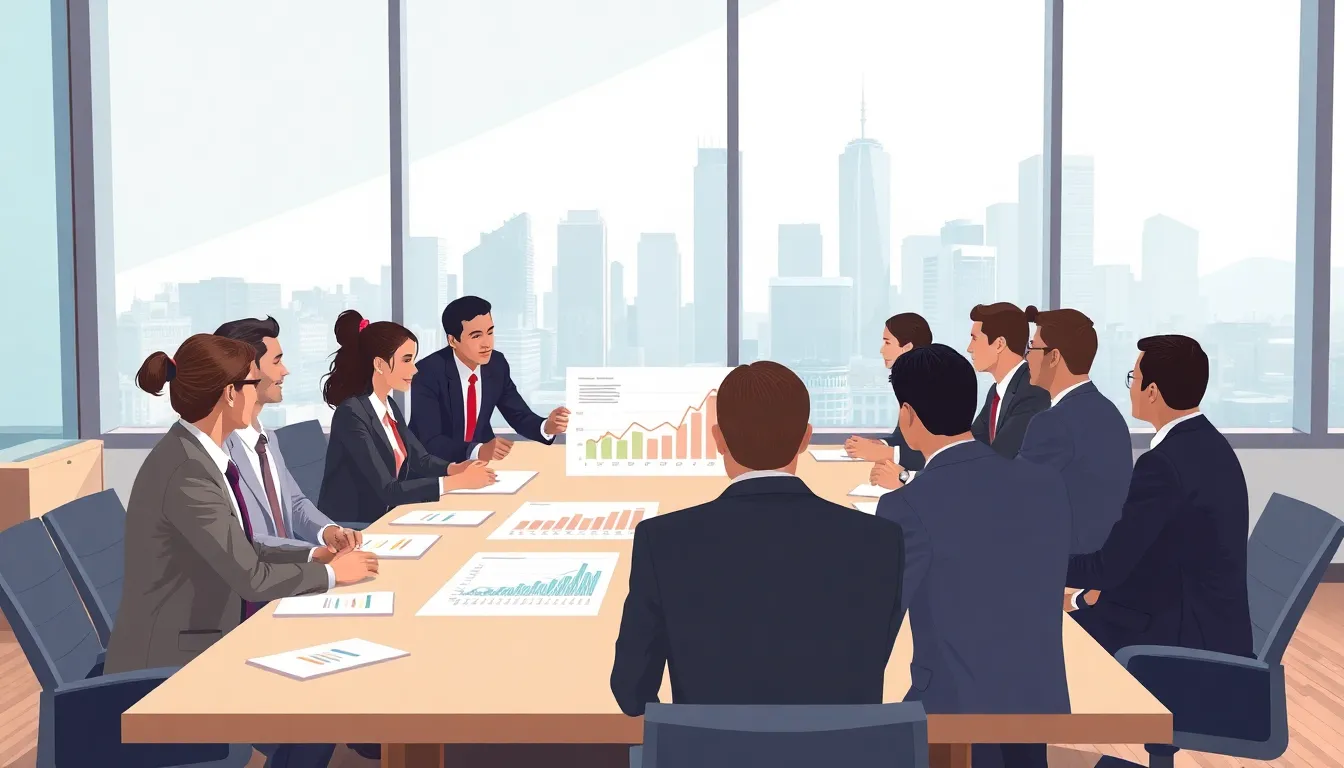In a world where the only constant is change, economic scenarios are like the plot twists in a soap opera—unexpected and often dramatic. From booming markets to sudden downturns, understanding these scenarios can feel like trying to predict the weather in a chaotic storm. But fear not! Navigating through the economic landscape doesn’t have to be as confusing as assembling IKEA furniture without the instructions.
Economic Scenarios
Economic scenarios introduce a variety of potential outcomes based on different assumptions about future conditions. These scenarios provide a framework for businesses and policymakers to strategize effectively. Understanding the forces that drive economic cycles—from expansion to recession—remains crucial for informed decision-making.
Recessions, characterized by declining GDP and rising unemployment, can significantly impact consumer behavior. During a recession, reduced spending often leads to lower demand for goods and services. Conversely, during an economic boom, increased consumer spending stimulates growth and creates new job opportunities.
Economic models seek to predict these shifts by analyzing key indicators, such as inflation rates, interest rates, and consumer confidence. These indicators offer insights into the current economic climate and suggest possible future movements. For instance, high inflation may prompt central banks to increase interest rates to stabilize the economy.
Different scenarios help uncover risks and opportunities inherent in specific economic conditions. A scenario planning method encourages organizations to envision multiple futures based on varying assumptions. Such foresight equips leaders to respond proactively to changes in the market.
Investors, too, benefit from understanding economic scenarios. Analyzing trends helps identify sectors poised for growth or decline. For instance, technology and green energy sectors often thrive in expanding economies, while traditional manufacturing may struggle during downturns.
These insights promote effective resource allocation. Adopting adaptive strategies allows individuals and companies to navigate uncertainty while maximizing potential returns. Being prepared for various economic scenarios enhances resilience and fosters sustainable growth.
Key Factors Influencing Economic Scenarios

Understanding key factors influencing economic scenarios is essential for effective decision-making. Each factor plays a significant role in shaping the economic landscape.
Inflation Rates
Inflation rates represent the rate at which the general level of prices for goods and services rises. Significant inflation often leads to reduced purchasing power for consumers. Many economists monitor inflation closely to predict economic health. For instance, high inflation typically triggers interest rate hikes by central banks to curb spending. Lower inflation might encourage investment and spending, fostering economic growth. Additionally, inflation affects wages, impacting overall consumer sentiment and spending habits.
Employment Trends
Employment trends indicate the health of the labor market and influence overall economic growth. Increasing employment rates generally lead to higher consumer spending due to greater disposable income. Job creation in various sectors often signals economic expansion. Conversely, rising unemployment can result in decreased demand for goods and services, promoting a downturn. Various factors, such as technological advances and demographic shifts, impact employment trends significantly. Monitoring these trends helps investors and policymakers anticipate economic shifts and plan accordingly.
Global Trade Dynamics
Global trade dynamics encompass the exchange of goods and services between countries, which significantly impacts national economies. Tariffs, trade agreements, and geopolitical tensions affect the flow of trade. A favorable trade balance can enhance a country’s economic stability. International markets offer opportunities for expansion but also introduce vulnerability to external shocks. Trade dynamics often influence currency values, which further affect import and export levels. Understanding these complexities is crucial for businesses aiming to navigate the global market effectively.
Types of Economic Scenarios
Economic scenarios encompass various potential outcomes shaped by different conditions. Understanding these scenarios aids businesses and policymakers in crafting strategic responses.
Optimistic Scenarios
Optimistic scenarios forecast strong economic growth. These situations often emerge from increased consumer confidence and robust job creation. When businesses expand, investment rises, leading to higher GDP. Companies may lower prices due to increased competition, facilitating consumer spending. Growth in sectors such as technology and renewable energy exemplifies this. Additionally, strengthened trade relations can boost exports, further enhancing economic performance.
Pessimistic Scenarios
Pessimistic scenarios depict economic decline. Recurring recessions usually lead to negative GDP growth. Rising unemployment rates can shake consumer confidence, resulting in decreased spending. Industries like retail and hospitality often face significant challenges during downturns. Under these conditions, businesses might cut back on production or lay off employees. Inflated levels of debt can exacerbate this situation, causing financial strain across the economy. As a consequence, central banks might implement aggressive monetary policies to stabilize markets.
Stagnation Scenarios
Stagnation scenarios indicate periods of little to no economic growth. This situation often arises from persistent inflation coupled with stagnant wage growth. Consumers may hesitate to spend due to uncertain job security, leading to lower overall demand. Economic systems might struggle with high public debt, limiting government spending and investment. Businesses often face difficulty finding new markets or attracting customers, which can harm future growth prospects. An example includes instances where economies are caught in a “lock-in” effect, unable to shift beyond a certain economic threshold.
Implications of Economic Scenarios
Understanding the implications of economic scenarios is crucial for effective decision-making across various sectors. They offer insights that shape responses in policy, business, and consumer behavior.
Policy Responses
Governments adjust policies to meet the challenges posed by different economic scenarios. During optimistic scenarios, authorities may increase spending to support growth initiatives. In contrast, pessimistic scenarios often prompt governments to implement stimulus measures aimed at bolstering the economy. Policymakers monitor inflation rates closely, making adjustments to interest rates to control economic overheating or stimulate activity during downturns. Effective policy responses mitigate the impacts of negative scenarios and enhance economic resilience.
Business Strategies
Businesses adopt strategies based on evolving economic scenarios to maintain competitiveness. Companies invest in innovation and market expansion during optimistic times, seeking to capitalize on consumer demand. Conversely, in pessimistic contexts, organizations often focus on cost-cutting measures and efficiency improvements. Scenario planning becomes essential for businesses to anticipate changes and adapt their strategies swiftly. A proactive approach helps firms identify growth opportunities while minimizing risks associated with economic uncertainty.
Consumer Behavior
Consumer behavior shifts significantly in response to economic scenarios. Increased confidence during a boom leads to higher spending, as individuals feel secure in their financial situations. However, during downturns, consumers tend to prioritize savings and reduce discretionary spending. Understanding these behaviors enables businesses to tailor their marketing strategies effectively. Moreover, consumer sentiment influences economic recovery, as spending trends directly impact demand for goods and services in varying economic climates.
Conclusion
Economic scenarios play a pivotal role in shaping strategies for businesses and policymakers alike. By recognizing the potential outcomes of different economic conditions, leaders can better prepare for the unexpected twists and turns of the market.
Understanding the dynamics of inflation rates employment trends and global trade is essential for making informed decisions. This awareness allows organizations to navigate challenges and seize opportunities effectively.
Ultimately the ability to anticipate various economic scenarios fosters resilience and drives sustainable growth. As the economy continues to evolve staying informed and adaptable will remain key to thriving in an ever-changing landscape.

